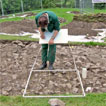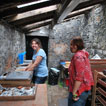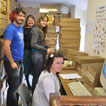Excavation is only the start of a long and complex process. After we have filled the holes in, left the site and put the tools away, we have to make sure that all the drawings, photographs, written records and finds we have taken from the site are in order and have been properly catalogued. With the finds, we have to make sure everything is washed (if we are still finding things up to the end of the dig there isnít usually time to finish this on site). We then have to identify all the finds well enough to decide which will need to be looked at by a specialist. We make this decision by considering what information they will be able to give us about the site itself, or about farming, trading or other activities in the area around. We also need to work out how much time we will need for everything to be studied - not just the finds but also the site records - and how long it will take to write the report. Once we have done that, we will be able to judge how much it will all cost.
When we had worked out how much that would be, we applied to Cadw for another grant to allow us to get the work done. Then we had to send the finds off to the specialists we had identified. In this case, it was the medieval pottery, medieval metalwork and carved bone, all of which went to Dr Paul Courtney at Leicester University; the animal bones and mortar, which were studied by Martin Locock, one of our trustees; and the medieval glass for which one of our Project Officers, Rowena Hart, produced the report. Charred plant remains went to Lampeter to be looked at by Astrid Casteldine of Trinity St Davids, with whom Cadw has a contract to look at environmental evidence. We also had the sand sample from Trench 1 examined by Tom Cotterill of the geology department in National Museum Wales, to see whether whether it had been perhaps deposited by a glacier, or it had arrived on the site through being blown on the wind. We thought this could be particularly important, since many sites around the coast of South Wales had been severely affected by sandstorm in the later Middle Ages, such as Rhossili, Penmaen Burrows or Kenfig, where whole communities had to be moved.
Back in the office, we go though all the records so that we can write a complete account of all the structures and deposits we had found on site. As this is very long-winded, we donít publish it as it stands - we decide what is important and write the site up in such a way as to bring out the significance of our discoveries. All the plans and sections drawn on site then have to be drawn up so that the reader will be able to follow our description. The reports on the finds come back from the specialists and we decide how they will affect our results and what will need to be included in the report.
The most interesting results were from the mortar and the glass. Martin was able to tell us that the mortar over the top of the tower foundations was of a late 18th century type, so now we think that it must have been reconsolidated then, and perhaps the standing, inner walls of both gate towers may have been refaced at the same time. When Rowena studied the glass, she was able to see that most it came from window-glass windows, so now we have another clue to the appearance of the castle, although most of it was too damaged for her to be able to distinguish any colours other than green and turquoise. And Tom confirmed that the sand had been deposited by water action or (most likely) by a glacier, so it wasnít the result of a medieval sandstorm filling up a ditch around the castle.
At the end of the process, and the catalogues, reports and finds were boxed up, ready to be deposited in Swansea Museum. Thanks to everyone who took part, particularly the students and volunteers who helped to catalogue the finds.







